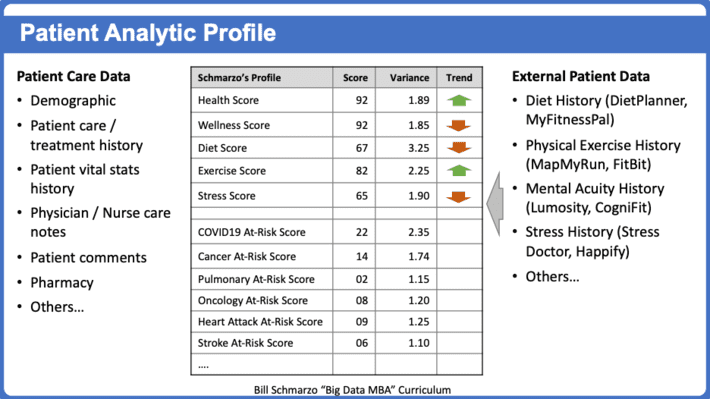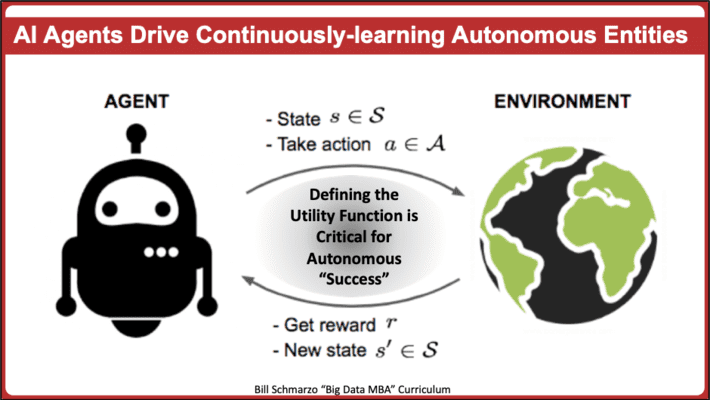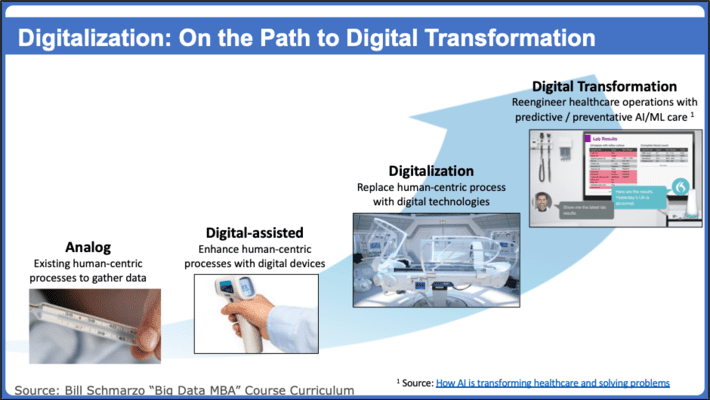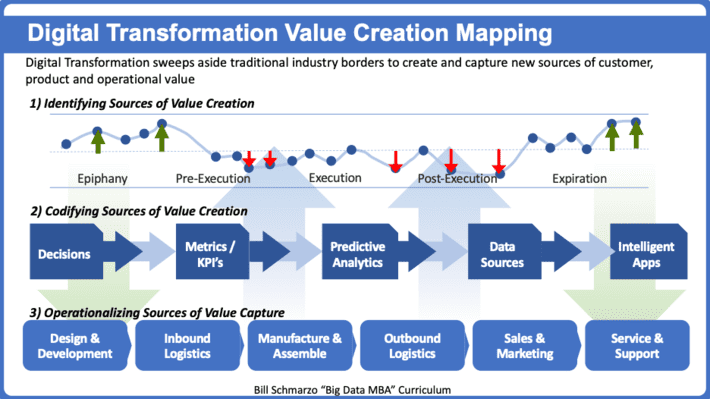The COVID-19 crisis has hammered home the importance for organizations to become more digital. And I suspect that most organizations are thinking that just means being able to support remote customer engagements and business operations. But that’s not nearly sufficient. Organizations that are thriving during COVID-19 are those that have gone beyond just “digitalizing” their engagements and operations, but are actively leveraging granular customer, product and operational data to build analytic profiles (digital twins) around which they can optimize key business processes and uncover new revenue opportunities.
For example, OpenTable is helping their customers avoid long lines at grocery stores. OpenTable provides a free restaurant reservations app for diners. However, with a quick pivot, OpenTable is leveraging its digital prowess and deep customer and operational insights to expand their market by capturing customers who want to avoid long waits at grocery stores.
So, here are the lessons that Post COVID-19 survivors can take from firms leading the Digital Transformation charge.
1) Analytic Profiles and Digital Transformation
Leading digital proficient organizations (Google, Facebook, Amazon, Apple) leverage low-latency, granular data about each customer/visitor transaction and engagement to codify their areas of interest in order to deliver hyper-individualized, dynamic, predictive messages and product recommendations. And these firms create Analytic Profiles to accomplish this.
Analytic Profiles codify detailed predictive insights for each of the organization’s “customers” that facilities the delivery of hyper-individualized, dynamic, predictive messages and product recommendations. An Analytic Profile codifies the behaviors, preferences, propensities, inclinations, tendencies, interests, associations and affiliations for each individual customer, much like how a “Credit Score” codifies an individual’s likelihood to repay a loan.
For example in the healthcare industry, Patient Analytic Profiles could digitally transform healthcare companies by creating granular patient, disease, treatment, medicine, fitness, wellness, doctor, hospital, etc. analytic insights – think propensity models and prescriptive scores – to digitally re-engineer key healthcare capabilities and introduce new individualized services including precision medicine, precision welfare, remote diagnostics, predictive world population health, wellness digital advisory, and prescriptive health monitoring (see Figure 1).

The application of Patient Analytic Profiles means the death to blanket operational and policy decisions, replaced by patient-specific precision healthcare and wellness actions like what the digital marketing did with precision, hyper-personalized, 1-to-1 marketing.
Lesson #1: Granular, actionable analytics will be built at the individual level using Analytic Profiles. Blanket operational and policy decisions will give way to hyper-personalized recommendations and treatments.
2) AI-driven Autonomous Policies
Policies – the rules or laws that guide an organization – are the foundation for any successful operation. Policies document the principles, best practices and compliance guidelines that aid decision-making in supporting the consistent and repeatable operations of the business. Heck, an organization’s culture is better defined by its policies than by the character of its leadership.
But what if these policies weren’t just static, if-then rules, but were instead AI-based algorithms that learned and evolved based upon the constantly evolving state of the environment in which the business operates?
An “AI-driven Policy” is a codified set of agent-based (human or machine) analytics that guide actions (or decisions) based upon current state (or environment) that optimize, automate and operationalize (scale) an organization’s business and operational models (see Figure 2).

Using Deep Reinforcement Learning, we can transition from static policies to autonomous policies that learn how to map any given situation (or state) to an action to reach a desired goal or objective…with minimal human intervention. These autonomous policies would dynamically learn and update in response to constantly changing environmental factors such as pandemics, climate change, economic conditions, trade wars and international conflicts.
Lesson #2: AI can enable updated, more relevant operational and policy decisions by continuously learning and adapting based upon most current data… with minimal human intervention.
3) Digitalization on the Way to Digital Transformation
Digitalization is the integration of digital technologies such as web-based apps, mobile devices, and sensors into existing business and operational processes. For example, Digitalization enhances or replaces human-centric process with digital technologies, such as transmitting current patient health and wellness data to the cloud using mobile devices, apps and sensors on a more granular basis versus requiring patients to physically travel to the care facility on an as-needed basis (see Figure 3).

Digital Transformation, on the other hand, leverages the growing wealth of Big Data and IOT data with AI/ML to uncover new customer, product, service and operational insights to re-engineer the organization’s business models to optimize key business and operational processes and create new revenue streams. Digital Transformation means creating a culture of continuous learning and operational adoption fueled at the front-lines of customer and/or operational engagement; of creating an AI-powered organization by rewiring the organization value creation processes from the bottom up. This includes:
- Transitioning from siloed work to interdisciplinary collaboration.
- Moving from experience-based, leader-driven decision making to data-driven decision making at the front-line of customer engagement and operations.
- Transforming the organization from rigid and risk-averse to agile, experimental, and adaptable.
- Become value-driven within the frame of customer journey centricity.
Lesson #3: Digital Transformation is more than just Digitalization; Digital Transformation is about re-engineering your customer engagements and business operations with continuously-learning AI/ML capabilities to derive and drive new sources of customer, product, service and operational value.
4) Continuously Identify, Codify and Operationalize Sources of Value
Finally, Digital Transformation knows no artificially-defined industry borders. Digital Transformation is about developing intimate and actionable “customer” insights no matter where they are on their journey and using those insights to re-engineer the organization’s value creation processes (see Figure 4).

Digital Transformation requires organizations to master four aspects of value creation:
- Aspect 1: Embrace an open culture that encourages different perspectives to identify, value and prioritize the organization’s sources of customer, product and operational value.
- Aspect 2: Codify (in AI, deep learning, machine learning and reinforcement learning models) the sources of customer, product, service and operational value.
- Aspect 3: Operationalize (embed) the codified sources of customer, product and operational value into your operational systems and ecosystems.
- Aspect 4: Create a continuously-learning operational environment where the organization learns and adapts at the front-line of every “customer” interaction or operational activity.
Lesson #4: The heart of Digital Transformation is combining an analytics-first mentality with an open, collaborative culture which is continuously learning and adapting to changing customer and market needs.
Summary
The COVID-19 pandemic, and the resulting social ramifications, has accelerated organizations mandate to digitally transform their operations. And while digitalizing your current human-centric processes will move you closer to your digital transformation vision, that’s like stating that you’re going to the moon, climbing a tree and declaring you are closer. Sorry, but you can’t get to the moon from the top of a tree.
The COVID-19 crisis mandates a totally new way for organizations to combine their digital, analytic and cultural assets – digital to provide new means for remotely interacting with customers and your ecosystem while capturing more granular data from those interactions, analytic to create detailed profiles around which to drive operational and policy decisions, and cultural to create an environment where your most relevant, most actionable “aha’s” don’t necessary come from Mahogany Row.
The world is full of constant change, and even more is coming. So, get used to it. Digital Transformation is only hard if you don’t know where your customers are going.
